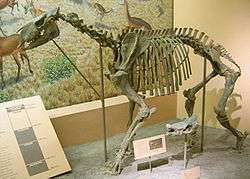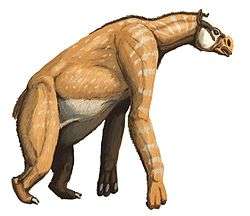Chalicothere
| Chalicothere | |
|---|---|
 | |
| Moropus elatus at the National Museum of Natural History, Washington, DC | |
| Scientific classification | |
| Kingdom: | Animalia |
| Phylum: | Chordata |
| Class: | Mammalia |
| Order: | Perissodactyla |
| Superfamily: | †Chalicotherioidea |
| Family: | †Chalicotheriidae Gill, 1872[1] |
| Type genus | |
| †Chalicotherium J. J. Kaup, 1833 | |
| Subfamilies | |
|
†Chalicotheriinae Gill, 1872 | |
Chalicotheres (from Greek chalix, "gravel" + therion, "beast") is an extinct group of herbivorous, odd-toed ungulate (or perissodactyl) mammals spread throughout North America, Eurasia, and Africa from the Middle Eocene until the Early Pleistocene, existing from 46.2 mya to just 781,000 years ago [3]
Description

Unlike modern perissodactyls, chalicotheres had long forelimbs and short hind limbs. Consequently, chalicotheres probably moved with most of their weight on their short, strong hind legs. Their front legs had long, curved claws indicating they knuckle-walked like giant anteaters today. Fossil remains have shown thick, developed front knuckles. It was once thought that the claws were used to dig up roots and tubers, but the wear on the claws and teeth do not suggest that they dug or ate dirt-rich foods such as tubers. The chalicotheres probably used their claws to strip vegetation from trees and to forage for food. Chalicotheres did not have front teeth in their upper jaw, and their back teeth show little wear, suggesting that they probably were selective browsers. It used its long forearms and curved claws to hook down leafy branches in the wooded savannahs in which it lived.[4]
The chalicotheres' lifestyle, anatomical design, posture, and locomotion are very different from those of virtually all quadrupedal ungulates, indicating convergence with other large, partially bipedal mammals such as ground sloths, great apes, and bears (especially giant pandas).
Evolution
They evolved around 46 million years ago from small, forest animals similar to the early horses. Many chalicotheres, including such animals as Moropus and Chalicotherium, reached the size of a horse. By the late Oligocene, they had divided into two groups: one that grazed in open areas and another that was more adapted to woodlands. They died out around 781,000 years ago, with Nestoritherium being the most recently dated chalicothere.[5] Chalicotheres are related to the extinct brontotheres, as well as to modern day horses, rhinoceroses, and tapirs.[6]
Cryptozoology
Some cryptozoologists have hypothesized that the (supposedly carnivorous) cryptid from Africa called the Nandi Bear could be a chalicothere.[7]
References
- ↑ Gill, Theodore (1872). Arrangement of the Families of Mammals. Smithsonian Miscellaneous Collections. 230. Washington: Smithsonian. pp. 8, 71, 76.
- ↑ Coombs, Margery C. (13 February 2009). "The chalicothere Metaschizotherium bavaricum (Perissodactyla, Chalicotheriidae, Schizotheriinae) from the Miocene (MN5) Lagerstatte of Sandelzhausen (Germany): description, comparison, and paleoecological significance". Paläontologische Zeitschrift. Berlin / Heidelberg: Springer. 83 (1): 85–129. doi:10.1007/s12542-009-0004-x.
- ↑ "Fossilworks: Chalicotheriidae". paleodb.org. Retrieved 2016-04-19.
- ↑ Palmer, D., ed. (1999). The Marshall Illustrated Encyclopedia of Dinosaurs and Prehistoric Animals. London: Marshall Editions. p. 260. ISBN 1-84028-152-9.
- ↑ "Fossilworks: Nestoritherium". fossilworks.org. Retrieved 2016-04-19.
- ↑ Savage, RJG; Long, MR (1986). Mammal Evolution: an illustrated guide. New York: Facts on File. pp. 198–199. ISBN 0-8160-1194-X.
- ↑ The Nandi Bear: Ferocious killer from the past Archived May 27, 2007, at the Wayback Machine. on cryptozoology.com